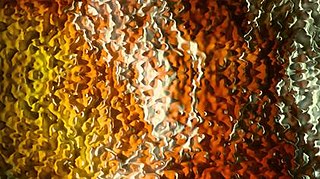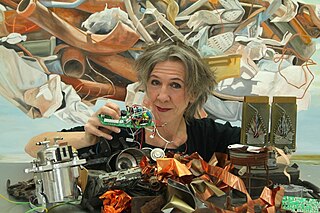
Ludwig Eduard Boltzmann was an Austrian physicist and philosopher. His greatest achievements were the development of statistical mechanics, and the statistical explanation of the second law of thermodynamics. In 1877 he provided the current definition of entropy, , where Ω is the number of microstates whose energy equals the system's energy, interpreted as a measure of the statistical disorder of a system. Max Planck named the constant kB the Boltzmann constant.

UBERMORGEN.COM is a Swiss-Austrian-American artist duo founded in 1995 and consisting of lizvlx and Luzius Bernhard. They live and work in Basel, S-chanf near St. Moritz and in Vienna, where both are professors at the University of Applied Arts Vienna.

The University of Applied Arts Vienna is an arts university and institution of higher education in Vienna, the capital of Austria. It has had university status since 1970.

The Gottfried Wilhelm Leibniz Prize, or Leibniz Prize, is awarded by the German Research Foundation to "exceptional scientists and academics for their outstanding achievements in the field of research". Since 1986, up to ten prizes have been awarded annually to individuals or research groups working at a research institution in Germany or at a German research institution abroad. It is considered the most important research award in Germany.

The Austrian Academy of Sciences is a legal entity under the special protection of the Republic of Austria. According to the statutes of the Academy its mission is to promote the sciences and humanities in every respect and in every field, particularly in fundamental research.

Theo Watson is a British artist and programmer. His art work includes interactive video, large-scale public projections, computer vision projects, and interactive sound recordings which have featured in museums and galleries across the world including Museum of Modern Art, New York Hall of Science, Tate Modern amongst others. Watson is a partner at Design I/O, a Cambridge-based interactive design firm known for cutting edge, immersive installations. He is also co-founder of the programming toolkit openFrameworks, co-creator of the EyeWriter and a virtual fellow at Free Art and Technology Lab.
Frederick Douglas Stephan "Fred" Baker was an Austrian-British filmmaker, media scholar, and archaeologist.
Tom Corby and Gavin Baily (1970) are two London based artists who work collaboratively using public domain data, climate models, satellite imagery and the Internet. Recent work has focused on climate change and its relationship to technology and has involved collaborations with scientists working at the British Antarctic Survey. Corby and Baily are founder members of the Atmospheric Research Collective, an experimental artist group which works in collaboration with climate scientists. For an overview of recent works see "An interview with artist and writer Tom Corb y".
Creative technology is a broadly interdisciplinary and transdisciplinary field combining computing, design, art and the humanities. The field of creative technology encompasses art, digital product design, digital media or an advertising and media made with a software-based, electronic and/or data-driven engine. Examples include multi-sensory experiences made using computer graphics, video production, digital music, digital cinematography, virtual reality, augmented reality, video editing, software engineering, 3D printing, the Internet of Things, CAD/CAM and wearable technology.
Michał Gryziński was a Polish nuclear physicist specialized in plasma physics. In 1965 he developed some widely used empirical models to reproduce some of the results of electron scattering experiments.

University of Tartu Viljandi Culture Academy is an Estonian institution of higher education, situated in the provincial town of Viljandi, central Estonia. The UT Viljandi Culture Academy merged with the University of Tartu in 2005. The UT VCA has been teaching professional higher education and performing applied research within information science, culture education and creative arts since 1952. The academy has about 1000 students, half of whom are open university students. The teaching and instruction are based on the continuity and sustainability of Estonian native culture enriched by new impulses which widen the notion of traditional culture. As of 2021, the Director of the institution is Juko-Mart Kõlar.
Monika Ludwig is an Austrian mathematician, University Professor of Convex and Discrete Geometry at the Vienna University of Technology.
Oliver Rathkolb is an Austrian historian and professor for contemporary history at the University of Vienna.
Media art history is an interdisciplinary field of research that explores the current developments as well as the history and genealogy of new media art, digital art, and electronic art. On the one hand, media art histories addresses the contemporary interplay of art, technology, and science. On the other, it aims to reveal the historical relationships and aspects of the ‘afterlife’ in new media art by means of a historical comparative approach. This strand of research encompasses questions of the history of media and perception, of so-called archetypes, as well as those of iconography and the history of ideas. Moreover, one of the main agendas of media art histories is to point out the role of digital technologies for contemporary, post-industrial societies and to counteract the marginalization of according art practices and art objects: ″Digital technology has fundamentally changed the way art is made. Over the last forty years, media art has become a significant part of our networked information society. Although there are well-attended international festivals, collaborative research projects, exhibitions and database documentation resources, media art research is still marginal in universities, museums and archives. It remains largely under-resourced in our core cultural institutions.″

Coded Cultures is a conference and festival series developed by the Austrian artist collective 5uper.net and since 2016 is included in the Research Institute for Arts and Technology. The first Coded Cultures focused on the theme 'Decoding Digital Culture' and took place over two weeks in May 2004 at the Museumsquartier in Vienna. The 2009 version of the conference and festival was a bi-national event that took part in Austria and Japan as part of the official "Japan - Austria Friendship Year 2009". Further implementations of the festival have discussed topics such as Open Source Hardware, Right to repair, New media art and digital art in cooperation with the apertus AXIOM project and the University of Applied Arts Vienna, the Transmediale Festival and the ISEA.

The Research Institute for Arts and Technology (RIAT) is an independent and international research institute established in 2012 in Austria and operating internationally. The aim of the institute is to investigate how technology and art can relate and inform each other in areas that include: open hardware, publishing, epistemic culture, cryptocurrencies and the blockchain. In 2017 RIAT was recognized by the European Commission and Ars Electronica for innovation at the interface of science, technology and art with a STARTS Prize Honorary Mention.

Günther Selichar is an Austrian visual artist.

Patricia Olynyk is a Canadian-born American multimedia artist, scholar and educator whose work explores art, science, and technology-related themes. Known for collaborating across disciplines and projects that explore the mind-brain relationship, interspecies communication and the phenomenology of perception, her work examines "the way that experiences and biases toward scientific subjects affect interpretations in specific contexts."

Maria Temnitschka is an Austrian artist. At the beginning of her artistic career Maria Temnitschka designed and created jewellery and objects made of metal. Later she reoriented to painting - at first abstract, since 2000 figurative representation. Her preferred techniques are oil painting, drawing, experimental photography, object art.












